The Fir Tree Inn – 1900 to 1949
This is the third part of the history of the Fir Tree Inn, Woburn Sands. The new century had just started and the pub had been run by successful businessman Benjamin Garrett since 1889.
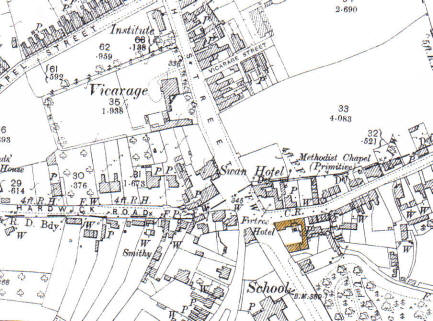
1900 seems to have been a quiet year, after some of the recent news stories, apart from the occasional late licence application for club suppers. In June 1900, Garratt applied for and was granted hour’s extension for a visit by Messrs. Waterlow’s employees from Dunstable, on the occasion of their annual bean-feast. Then in July, the Luton Branch of the National Federation of Assistant Teachers enjoyed a day at Woburn Sands with catering by the Fir Tree. In 1902, the Dunstable and District Unionist Club came, 50 strong, expecting to meet their candidate for South Beds, George Elliot, who was coming up from London, but a telegram arrived stating he had got to Dunstable and was not able to get a carriage to complete the journey. Toasts and congratulations were made to Balfour on becoming Prime Minister.
In 1901 comes the first connection between Garrett and the local Liberal party. In February, he organised a meat tea for Mr. Beaumont, the late Liberal candidate for North Bucks., with speeches and music, no doubt to raise funds.
The census this year gave Garrett as a “Hotel Keeper – Pub“, with no occupation listed for his wife. Also at the pub were Catherine L. Garett, their niece, 23, born in Oxford, acting as a Barmaid and Alfred Garrett, 16, born in Woburn, as a Groom (no relationship given). Also present was Mary Johnson a 40-year-old domestic servant born in Ireland.
The large meeting room was an ideal spot for the local ‘K’ Company of the 3rd Volunteer Battalion, Beds. Regt. to do some drill practice, under Lieut. Cecil Grimshaw, commander. Then St. Mary’s Mothers Meeting came from Bedford and enjoyed a meet tea after visiting Woburn Abbey in July and 40 members of the Kempston Liberal Club in August. In November, the Garrett’s were taken to Court by local Dr. J. Grant, claiming an unpaid bill of £2 6s., but it had been paid off before the case came up.
The next year, Garrett was advertising again, including the fact that he had now been the landlord for 13 years, quite an achievement in the area. A similar advert ran in the Luton Advertiser too.
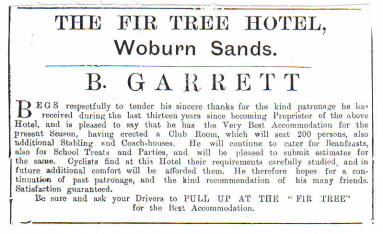
It was thirsty work, doing drill practice in the hall. Leighton Buzzard Observer & Linslade Gazette 25th March 1902: “EXTENSION OF TIME. Mr. Benjamin Garrett, of the Fir Tree Inn, Woburn Sands, applied for and was granted a permit to keep his house open for the accommodation the members of the K. Company 4th Beds. Rifle Volunteers, hour and-a-half beyond the usual time – namely, until half-past eleven o’clock, on the night of Saturday, March 29th, the occasion being a smoking concert promoted by the volunteers.”
The following report of a wedding celebrated at The Fir Tree, is interesting not only as they were related to Benjamin Garrett, but also so you can see the level of detail that local newspaper reports went into at the time. From the Bucks. Herald, 4th October, 1902:
“WAVENDON. Wedding. A pretty wedding was solemnised at Woburn Sands Church on Wednesday, 24th ult., the contracting parties being Mr. P. Charles Brill, second son of Mr. E. Brill, of Fen Farm, Wavendon, and Miss Katherine Louise Garrett, eldest daughter of the late Mr. R. Garrett, of Milton Keynes. The officiating clergyman was the Rev. G. Fiennes, of Milton Keynes. The bride was given away by her uncle, Mr. Harry Frost, of Oxford, Mr. Thomas Burgess acting as best man. After the ceremony a reception was held at the bride’s uncle’s, Mr. B. Garrett, of the Fir Tree Hotel, where very pleasant time was spent. The presents were of a very useful character, and were as follows:- Bride’s mother, wedding dress and bath towels; bridegroom’s father and mother, bedstead and bedding, mahogany dressing table, and glass marble clock, bride cake, whatnot, kitchen table, and half-dozen knives and forks; Mr. H. Frost (bride’s uncle), breakfast service and brooms; Mrs. Frost, Damask tablecloth; Cousins Laura, spirit lamp and coffee pot; Archie, tea caddy; Roland, glass water jug; Dorris, jam dish and salts; Ivy, half-dozen plates; Mr. and Mrs. J. Frost, alarum timepiece; Mrs. J. Cox, afternoon tea cloth; Mr. Albert Frost, dish; Mr. Smith, cheese dish; Mr. B. Garrett (bride’s uncle), devotional chair; Mrs. B. Garrett, various presents; bride’s sisters, pictures, tea cosy, and cushion; bridegroom’s two table lamps and ornaments; Mr. T. Burgees (friend to bridegroom and best man), half-dozen chairs; Rev. R. N. Barrett (Droylesden), Damask tablecloth; Mr. Stringer (Droylesden), antimacassars; Mr. F. and Miss A. Brazier, carving knife and fork; Mrs. and family (Crab Tree Farm), afternoon tea tray and ornaments; Miss Burgess, ornaments; Miss Cole (Newport Pagnell), silver jam spoon; Mr. F. Taylor (Guildford), ornaments; Mr. Odell table lamp; Mr. and Mrs. Tansley, china kettle; Cousins, Polly and Amy, egg stand, cruet, and pair ornaments; Sergeant and Mrs. Plater, silver butter dish; Mr. Bunce (Weston Turville), silver cruet; Mr. Collins (Fenny Stratford), handsome ornaments; Mr. Swain, trinket set; Mr. T. G. H. Berry, silver breakfast cruet; Mr. J. Dudley and Mr. McMurtrie, rocking chair; Miss Lucy Bithrey, ornaments; Mr. Charles Brill, overmantel; friend from Weston Turville, bath towels and socks; etc., etc. On Thursday evening another party was held at the bridegroom’s parents. Fen Farm, when a very pleasant time was spent. The happy couple subsequently left for Oxford, where the honeymoon is being spent. The Woburn Sands Prize Band was in attendance, and rendered selections of music in excellent style.”
There was another licensing report in 1903, which described the house as being clean and in good repair. The estimated yearly rental was £45, more than double the amount of the nearby Royal Oak. Garrett again had to appear in court in a case against George Munn, who had been ejected from The Fir Tree and found by the police drunk on the highway. He was charged with being drunk and disorderly, but did not appear, so was fined 10s. with 9s. 6d. costs.
We are now well into the age of the captured image and I am able to illustrate this story with period photos. Cameras had been around since the 1840’s, but I have seen very few photographs of Woburn Sands pre-1900. Pictures of the nearby thatched version of the Friends Meeting House are probably that early, as it was demolished in 1901 to make way for the building we see today. People would have sat for portrait pictures, but these are usually indoors and more often than not have no details about who the sitter is. We know that Blake & Elgar, photographers of Bedford, held a studio every Thursday in the High Street in 1891.
Picture postcards changed all this. The Post Office had allowed postcards from 1894, although the image and message had to be on the same side until 1902. New production methods meant colour images were available more cheaply and more widely than ever before and people clamoured for local views that they could send to their friends. Postcard collecting became a huge hobby, with many famous collectors. Everyone vied to have the most cards, which is why so many cards that can still be found today weren’t actually sent, they were just filed away in albums, to be shown off to friends.
Fred Newman was one of the local postcard sellers in Woburn Sands. He had an antique shop and obviously wanted visitors and passers by to enter, so what better than to have a rack of appealing local views by his door? He was a keen photographer himself and one of his order books survives at Bedford. (BARS Z251/174) That’s how we know that Garrett bought six postcards of The Fir Tree in October 1905 from him. Whether he sold the cards on to his guests, used them to advertise the Hotel, or used them personally to send to friends, we cannot tell, but Garrett was eager to use images of the Hotel in adverts, as his entry in “Gregory’s Guide and View Book of Woburn Sands, Aspley Guise and Woburn” in 1904 shows. This charming 64-page book is full of adverts for local businesses, postcard-type views and some history and description of the village and surrounds. The Fir Tree and the Swan are the only two adverts with photographs. There must have been some fierce rivalry between the two inns, both with such commanding positions in the centre of the village.
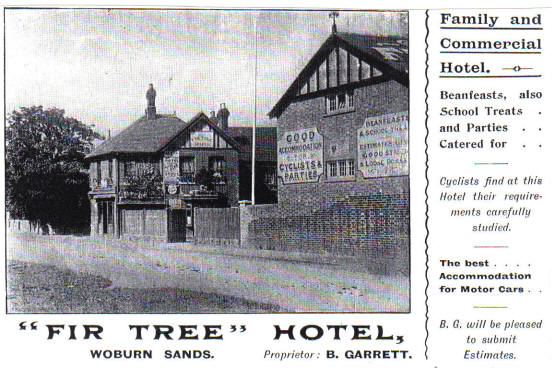
The picture of the Fir Tree was taken from across the road and shows the court yard (car park) was fenced in with a low wall topped with a 6″ wooden fence with a gate in the centre. There is a flagpole by the road, but no flag is flying. There are large adverts on the roadside wall of the Club Room and on the Hotel itself, as well as the Woburn Road-facing side of the Club Room roof! Garrett certainly maximised the available space for publicity.
The main upstairs windows of the pub are decorated with planted window boxes. The text that ran with the picture was the standard piece he ran in local paper adverts. The Hotel is also listed in the section under ‘Apartments’ and the Club Room also appears in the section on ‘Public Buildings’. The picture of the Swan looks quite stark by contrast, with no advertising hoardings or signs. The main text of the book waxes poetical about the delights of Woburn Sands, quoting at length from Bryant and Longfellow. This was on the back of the health resort reputation, but among the more picturesque descriptions, the author still finds place to complain about:
‘…the many houses, which in these days of hygiene, are an eye-sore to the sanitary reformer, but they are gradually being replaced by others built more in conformity with the needs of sanitary science.’
I have not seen any postcards of Woburn Sands or district with Newman’s name as a photographer, publisher or vendor and I wonder if the cards he sold were actually produced by Herbert Gregory, author of the above book? Gregory had his finger in many pies – he had served an apprenticeship with Powage Press in Aspley Guise, before setting up his own print works and stationers business in Woburn Sands. As the adverts in his own book confirm, he also sold postcards at 10 for 6d., let out boarding rooms, sold fancy goods and gramophone records and also sold (and rented out) pianos, organs and harmoniums!
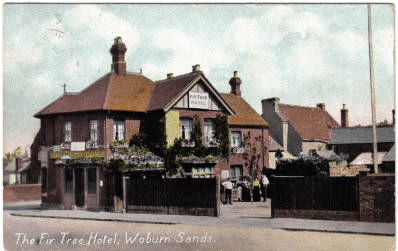
There is a nice postcard of The Fir Tree produced by Gregory. A coloured picture with what looks to be the Garretts in all their finery stood outside the main door and the earliest version I have seen was sent in July 1905. There seems to have been some artistic licence taken with the hand-colouring, but it’s a lovely picture. The ivy has spread higher up the outside of the main building, otherwise it looks very like the one used in Gregory’s Guide.
Grand trips out to Woburn Sands continued to use the Fir Tree for their meals. Fortunately, these attractive views do not convey the smells of that time. Next door to the Fir Tree, that horse-carcass dealer, who had already appeared in court in 1900, was still emitting the highly unpleasant odours from his business. In 1903, the courts took action against Frank Elmer again and forbade him from conducting business there any longer, as it was considered injurious to local health, there being no sanitary arrangements on the premises whatsoever. Garrett appeared as a witness again and said how he had to keep his windows and doors closed when the smell was too bad. Elmer sent his mother to defend him at the Court and she was very disgruntled at the ruling!
In 1906, the Club Room was used for the inquest into the death of ‘Dot’ Farmer, a 43-year-old labourer at the brickworks. He had helped out at a bad fire at The Cyclists Rest on his way home from work and then later that evening was seen heading towards the clay pit ponds down by the station. Nothing was seen of him again and his wife reported him missing the next day. The basket he had been seen carrying was discovered at the edge of one of the ponds and it was dragged and his body recovered. There was speculation that he had been looking for plovers eggs and may have been drinking. His wife Annie Eliza Farmer was left with six children to provide for. The jury handed over their fees for the case to the widow.
As well as their drill practice, the Fir Tree Clubroom was used for more lively activities by the Volunteers too, such as shooting! This report from the Beds. Times, 9th February 1906:
“WOBURN SANDS. A very enjoyable friendly shooting match took place in the gallery at the “Fir Tree”, Woburn Sands, on Saturday evening, when a team of six, composed the main of non-commissioned officers of the “I” Bletchley Company of the 1st Bucks. V.R.C., travelled over to try with a local Woburn Sands “six”. The practice made was at times excellent, and the result was in doubt up to almost the last shot. At the first range the Fenny Stratford team led, but again at the second distance Woburn Sands went to the front, but not with sufficient points to wipe out their original deficiency, their visitors winning the match in the end the close margin of 6 points.”
Woburn Sands was featured in Home Life magazine in August 1906, under “How and Where to spend a Happy Holiday”. The piece told how to obtain a licence to be allowed to pick the wild flowers of the woods, and be allowed access to private areas of the woods. It again pushes the airs of the area as being beneficial to invalids, and quotes prices of 15s. to 20s. per week for apartments. The 3rd class fare from London was just 5s. return.
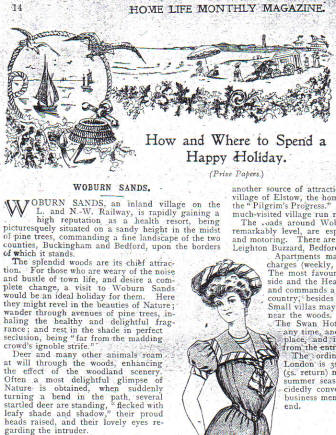
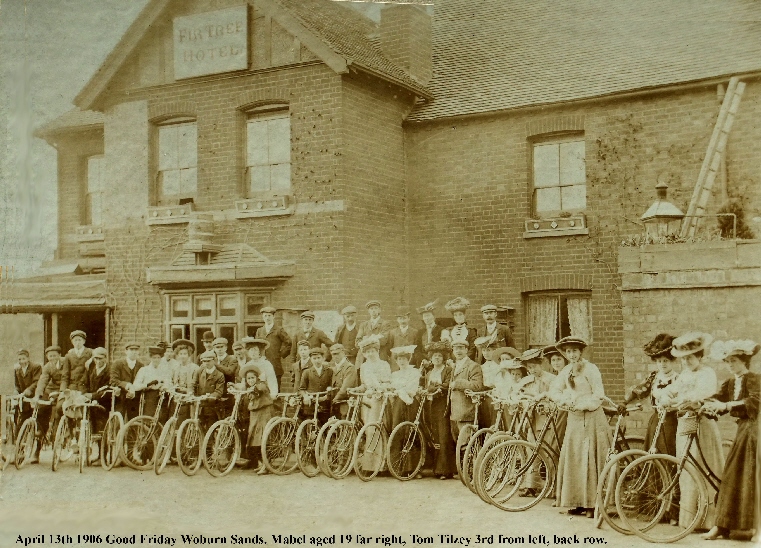
Mabel Tilzey (standing far right) recorded in her diary for Good Friday 1906: “Went to Woburn Sands [from Toddington] with club, My hat a great trouble – very dusty. Had photos taken. Went into woods, shower came on, Went back to Hotel. Had tea. Then had few songs. Started home at 6.30, rained again. Very muddy. “
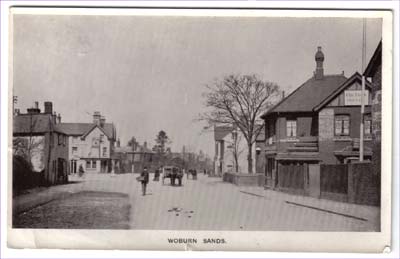
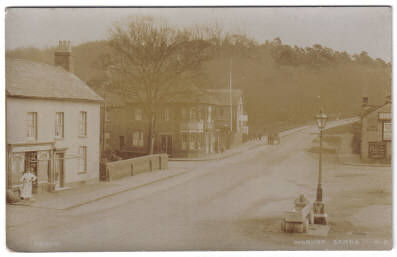
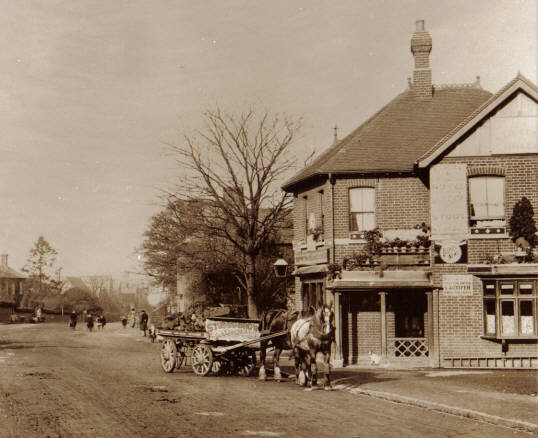
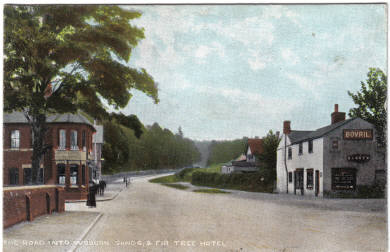
Postcards were an important part of Edwardian life and the Fir Tree even commissioned their own shots taken on the premises! This card show a lady with a little dog, in an exterior setting, which is unusual for those days when an interior studio was usually used, even if it had a (badly) depicted landscape view painted onto a backdrop. Given the design of the brick wall behind, I believe this shot was taken in the little yard at the rear of the carpark. Chalked onto the signboard at the base of the table is “Fir Tree Hotel, Woburn Sands”. It was sent by Ben Garrett to an address in Luton. Whether she is a family member or customer, is not made clear. But you can imagine the attraction of being able to provide postcards of the guests for them to send home etc.
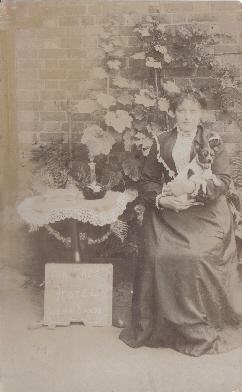
Great excitement was caused when Lord Rothschild’s Stag Hounds chased a stag into the village in 1909 and they managed to corner it in the porch of the Henry VII Lodge. Once captured, the Fir Tree stables provided an impromptu pen to hold it. Also in 1909, the Bedfordshire Times recorded that Miss Mary Garrett, late of The Fir Tree, had married Mr. Frank W. Jackson of The Leys.
In 1910, Garrett placed an advert in Kellys Directory, a precursor to the modern phone book. All the principle private residents of the town were listed, along with the commercial businesses and information about posting times, public offices such as the overseers and a little history about the public buildings etc. His advert specified that the Hotel dated from 1889 and used the catchy tag-line of “If you want serving well, go to the Fir Tree Hotel”. A push was also given to the local woods and how nice they were to walk in, but he boom time for visitors taking the airs was starting to wain. The advert featured the same Gregory postcard image as mentioned above. There was also a Tax Valuation this year, with the following description: “Ground: Bar and Jug Dept., Taproom, Smoke Room, Kitchen, Outside Kitchen for Summer Catering, store over. Basement: Cellar. First Floor: 4 Bedrooms. Two W.C.’s, Harness Room, Stable 3 boxes, 3 stalls with loft over, open carriage shed 3 bays, with dining & tea room over.” Garrett was now paying £25 a month in rent.
The next year, 1911, was a census year and Benjamin, now 63 and his wife Catherine, 61, are recorded at The Fir Tree with one domestic servant and one visitor, Harry Holland, an engineer born in Manchester.
The next year was an eventful one for the pub and the Garretts. In January, a Woburn man, Albert Farr came to the pub and said that his father, Frank Farr, needed 15s. to pay to the Rector of Wavendon, before he could start doing a job there. Garrett knew Frank and lent Albert the money with a receipt being given. Later Garrett met Farr Snr., who said he knew nothing about the job and they realised they had been tricked. By the time police caught up with Albert, he had also tricked 30s. out of a stationer in Ampthill with a story about needing money for the chauffeur of Woburn Abbey to pay a speeding fine, which was also untrue. As he had prior convictions for similar offences, he was sentenced to 9 months’ hard labour.
Garrett ran an advert on the front page of the Woburn & District Reporter from June to November, reading:
“If you want serving well go to THE FIR TREE HOTEL Woburn Sands, Family & Commercial Hotel. Established 1889. The Best Accommodation for Beanfeasts, School Treats, Parties and Cyclists. Special attention given to Large or Small Parties, Estimates submitted. Only the Best English Meat served. The Woods are now in all their Spring and Summer beauty, and are open to pedestrians. Those who have not visited Woburn Sands should not fail to do so this year. These Woods are open daily to the public from year to year. If you have not visited the Fir Tree Hotel, you will do well to give it a Trial, Satisfaction Guaranteed. Be sure and ask your Drivers to pull up at the “Fir Tree” for the best accommodation. Proprietor – B. GARRETT.”
The John Bull magazine picked up on the fact that Garrett’s ad was still running in November yet proclaiming that the woods were “…now in all their Spring and Summer beauty” and listed him under their “Takes the Biscuit” column where “…we present, in all good humour, the token to such of our contemporaries and others as may have distinguished themselves by some utterance or act.”
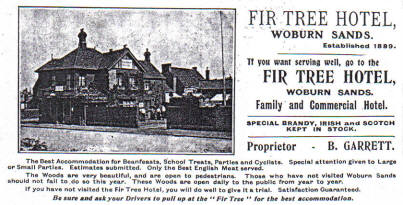
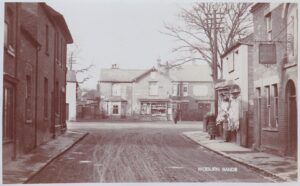
In May 1912, it was reported:
“On Tuesday a tramp visited Mrs. Newling’s shop and decamped with 12s. from the till. He went to the “Fir Tree” for refreshment, and this led to his undoing. Mrs. Garrett being suspicious kept her eye on him, and noted his departure, being able to give information to the police, which led them to scour the Brickhill and Sympson district, with the result that P.c.’s Gunn, Bonner, and Hughes met at Sympson and collared the “gentleman” with the money on him, and some postcards later found to have been taken from the Post Office here.”
In June, The Woburn Reporter ran a piece saying:
“The correspondence on local Liberalism in our columns has raised a good deal of comment, and as far as we can gather there is a general desire for meetings to be held in connection with matters prominently before the country. One reason given for “not” doing so is fear of a boycott, and another is no suitable room. No regard to the latter there is, or need be no difficulty in future. There is a fine, lofty room connected with the “Fir Tree,” away from the house, which is at the disposal of the party for payment of gas and firing, when necessary.”
But far the most intriguing newspaper reports began in September and rumbled on for over a month. From the North Bucks Times & County Observer:
“The Story of a Picture – For many years a small picture of no apparent great value has adorned the walls of one of the rooms of the Fir Tree Hotel, at Woburn Sands, the proprietor of which is Mr. B. Garrett, and there appeared every prospect of it continuing in its old place for more years to come. Unfortunately for the owner, a party from Newport Pagnell the other day paid a visit to the hotel, and one of these being a hotel proprietor, he was shown over a portion of the hotel. It was whilst viewing the rooms that the picture was noticed and an offer to purchase made. Mr. Garrett put a price upon it, and eventually it was sold for £1.
The picture represented the bust of a lady wearing a Gainsborough hat with a large plume, which had three distinct trades of blue in it. It is now pronounced to be an early work of Gainsborough. Such an unimportant portion of the household goods was it regarded that Mrs. Garrett, whose property it really was, is unable to state how she became possessed of it.
Little was thought of the transaction until it became known that the Newport gentleman, Mr. Rose of the Swan Hotel, had disposed of it for £50, and there were serious heart-burnings at the Fir Tree, when later news arrived that it had again changed hands for the big price of 760 guineas. Mr. and Mrs. Garrett are now naturally regretting the fact that they were for so many years “entertaining an angel unawares.” Probably had they remained in blissful ignorance to the end of the chapter it would have been better for their peace of minds. “Where ignorance is bliss, ’tis folly to be wise,” we are told, and it applies with exceptional force in this case.”
The Woburn Reporter also picked up the story the next week:
“MR. GARRETT’S PICTURE SALE – For a long time, rumour has been busy over a so-called’ “picture deal” at the Fir Tree Hotel, in which Mr. B. Garrett, the proprietor, came off a heavy loser. On Friday last, in a weekly paper there was a laboured attempt at wit in connection with it, and it may be well if the real facts are now made public, especially as Mr. and Mrs. Garrett are both wishful for it in the interest of all concerned. The picture referred to was one of a pair Mr. Garrett gave his wife some 24 years ago. It represented the bust of a lady wearing a Gainsborough hat with a large plume, and had three distinct shades of blue. Until about two or three months ago it adorned one of the walls in the Hotel. One day a gentleman came along and saw it; at his request it was taken down and the back taken out. Having examined it, he said “You can put it up now,” or words to that effect, and added, “How much will you take for it?” Mr. Garrett replied off-hand, “A couple of pounds,” not thinking of a sale, and while they were talking Mrs. Garrett twice informed the visitor that the picture was hers. Eventually an arrangement was made, and as the gentleman moved to his motor car with the picture, Mrs. Garrett, for the third time said, “That is my picture,” and tapping it, the visitor replied, “This lady has never ridden in a motor car.” As Mrs. Garrett retorted, “Motors were not about then,” the car started and departed.
The arrangement entered into unhappily only by word of mouth, was we are informed, that £1 was paid down, and in the event of the picture turning out good, and fetching a good figure, the visitor was to return and make it right with Mr. Garrett. Shortly after his departure the news came through that it had been sold for £50, and since then, it is said it has again changed hands for 750 guineas. Up to the present, however, notwithstanding that the gentleman has been twice approached, he has not returned to make matters right. Mr. and Mrs. Garrett naturally deeply deplore the loss of such a treasure, and regret the manner in which it left their hands.”
The first press report also prompted Garrett to write in to the North Bucks Times & County Observer to answer their piece:
“The Story of a Picture Deal – Mr. Garrett Explains.
To the Editor of the North Bucks Times. Dear Sir, In your issue of last week you had a report under the above title. As one, probably the most, interested in the matter, perhaps it may not be out of place if I draw your attention and that of your readers to one or two points. Your report states: “Mr. Garrett put a price upon it, and eventually it was sold for £1.” I did not put a price upon it. I asked £2, not dreaming of a sale, but when it came to a deal I did not sell for £1. That was the amount of money paid to me then but it was on the understanding that the gentleman who was purchasing, should, if he made a good sale, come again and make matters right between us. Now for another point. Your report further states “Such an unimportant portion of the household goods was it regarded that Mrs. Garrett, whose property it really was, is unable to state how she became possessed of it.” Allow me to state that it was one of a pair I gave her 24 years ago, and more than that, three times did she point out to the purchaser that it was her picture. On the third occasion he was moving with it to his motors car and, tapping it, he remarked “This lady has never ridden in a motor.” With that he jumped in and was gone We are now waiting for his return. Yours & c, Benjamin Garrett, Fir Tree Hotel, Woburn Sands. Oct.1st,1912.”
However, this was not the end of the matter, and the story was soon embellished as it travelled around the district. Last word was left to the North Bucks Times & County Observer. Most of the fuss seems to have been just idle gossip:
“The Romance of a Picture – Messrs. Christie’s Denial. Almost the chief topic of conversation here continues to be associated with picture which until recently adorned one of the walls of a room at the Fir Tree Hotel, and which passed out of the possession of Mr. B. Garrett, on the handing over of one sovereign. As readers are aware, it subsequently changed hands a second time, the purchasing price on this occasion being £50. The new owner, a Northampton dealer disposed of it, so the story goes, to a Luton gentleman for 750 guineas. On Thursday we were informed, in all seriousness, that the picture had since been sold, this time for the extraordinary figure of 2,000 guineas, and that Messrs. Christie, Manson and Co. the famous auctioneers, of London had negotiated the deal. We very much doubted the accuracy of this, however, and on telephoning to the above named firm this (Friday) morning we were informed, that there was no truth whatever in the rumour. They do not commence their picture sales until next month, and have not sold privately a Gainsborough for 2,000 guineas. They also volunteered the further information that they doubted very much whether a Gainsborough would realise such a sum.”
No more news from 1912, but in June 1913, the Luton Liberals came in force for an outing to the Fir Tree, as it was hoped that Mr. C. Harmsworth would be present. This picture is presumed to be a outing of Luton Liberals, as one of those present is thought to be Walter Haith. He was a staunch Liberal and taught at Waller Street school, Luton, from 1901 to 1914, before becoming the first headmaster of Tennyson Road school in Luton from 1915 -1933.
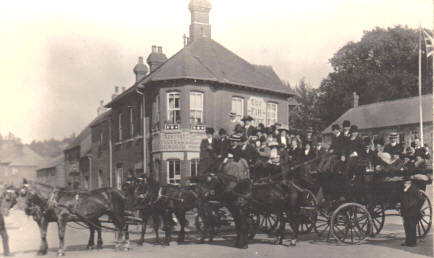
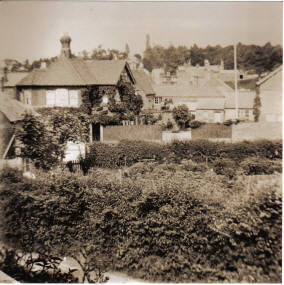
In August it was announced that Benjamin Garrett would be leaving the Hotel after 25 years in charge. The Woburn Reporter, August 30th: “The Fir Tree Hotel is shortly to change hands. After 25 years residence, Mr. Ben Garrett is retiring and his friends hope that he and his wife may live long and have good health to enjoy their well earned rest. Under his control the house has been conducted with an eye always on the spirit as well as the letter of the law, and he also has been what is almost a unique experience in the trade – a staunch supporter of Liberal principles all through. His follower, we hear, is to be Mr. C. Wynne, the change occurring next month.”
The Woburn Reporter, September 20th:
“Mr. B. Garrett wishes to convey his thanks to all, who during the past 25 years have patronised “The Fir Tree Hotel”, the position of landlord of which he only gave up on Friday last, Sept. 12th to go into a well earned, and he hopes, deserved retirement from business trade. Not only locally but from all quarters, his patrons have expressed appreciation of all they saw and obtained and now that he and his wife have left the scene of many happy years and strenuous days, they feel it only just to convey to one and all, thanks for their patronage and appreciation.”
…but they did not move very far to start with. Garrett was later sued by Mr. A. Boyes, the owner of “Sunny Villa”, a residence elsewhere in Woburn Sands, for three months rent on the house. Mrs. Garrett had rented it at £16 p.a., but then they had decided to leave Woburn Sands before the lease was up. They tried to give notice and had returned the keys, but this did not sway the Court and the Judge gave the case to the plaintiff with costs.
It would seem that the Garrett’s had tried to leave in a hurry as they were taking over a Benskin’s pub, the Greyhound at Billington. They ran it from June 1914 to December 1915. The inventory that Garrett took on from the previous landlord, J. T. Kinder, survives at Bedfordshire Archives (BML10/7/15) and shows the contents of the inn, right down to three enamelled spittoons. Some of Garrett’s early correspondence regarding the Greyhound was written on Fir Tree Hotel-headed notepaper, featuring Gregory’s postcard view of the pub.
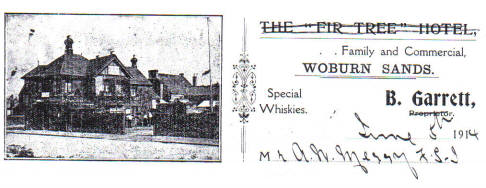
1913 to 1914 – Charles Henry Wynne
The new landlord of the Fir Tree in 1913 was Charles Henry Wynne. He was born in Wandsworth and had been an innkeeper at Putney for more than a decade (he was at the Railway Tavern, Upper Richmond Road in 1901) and later at Barnes. This is referred to in a report of a court case when Wynne left some belongings at Frederick Bowler’s house in Aspley Heath and had difficulty in retrieving them. This appears to have been his one-time father- or brother-in-law, as he had married an Elizabeth Bowler in 1880 in Husborne Crawley when he was 25.
By 1911, he was 56 and living at Aspley Heath with a different wife, aged 35, their 17-month-old son and his brother. His occupation is listed as ‘Independent’, but something must have tempted him back into the pub trade in 1913. Perhaps it was only intended to be a short stop-gap until a permanent replacement for Garrett could be found.
In January 1914, the Wynne’s experienced a fire at their residence, Orchard Cottage, on Aspley Heath. A large cupboard under the stairs containing firewood was found to be well alight at 5pm on a Monday evening. It was practically extinguished by the time the Fire Brigade arrived and Wynne and his family set about removing damaged furniture etc. to his own stables and also to the Fir Tree, of which he is mentioned as the landlord. At 6.30 the next morning, he was up early fetching his wife a cup of tea, when he glanced out of the window and noticed his stables were now well alight! Some smouldering furniture had re-ignited. This fire was more serious; the stables were completely gutted and the rear of the house was well ablaze. Wynne’s brother attempted to retrieve some of his goods but was overcome by the smoke and had to be rescued by the fire brigade and a local policeman. (North Bucks Times & County Observer – 17th January 1914)
By December 1914, Wynne had been replaced at the pub and his cottage in Aspley Heath was up to let. along with his “good, up-to-date, double-fronted shop” in the High Street, but I cannot find what his shop sold. Perhaps he wanted somewhere less combustible! They moved to Station Road.
1914 to 1924 – George Alexander
After Wynne’s eight months in charge, in April 1914 his replacement was George Alexander and his wife Margaret. George was born 1870, the son of a solicitor’s clerk living in Camberwell, London and was listed as “Clerk / Unemployed” in 1891. He had married Margaret Annie Edwards in the Spring of 1910 whilst still in Camberwell but appears in the 1911 census as a Coal Agent in Bromley, Kent.
They advertised the pub in the Wolverton Express from 8th May to 21st August 1914, pointing out the proximity to the new Golf Course at Aspley Guise:
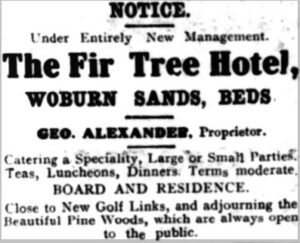
Unfortunately, Maggie Alexander died just six months after they moved in, aged 44. From the Beds. Times, 6th November 1914: “At midnight Friday (30th October) , Maggie, the wife of Mr. Alexander, of the Fir Tree Hotel, succumbed to a short and painful illness. It is not many months since they took possession of the house on its being given up by Mr. Wynne, and the utmost sympathy is felt for them.”
Her funeral took place at Norwood Cemetery, London and the mourners included the late Mayor of Southwalk and Lady Thornbill’s daughter. She left £295 16s. 6d. to her husband. After his wife’s death, George’s sister Jessie came to help him at the hotel.
In 1914, it was reported that almost all of the old Georges Square in Aspley Heath had now been demolished and the only building still remaining housed George Lee, the besom maker, last relative of the Lee family who once ran the Fir Tree, although it was noted that the brush trade was not what it once was.
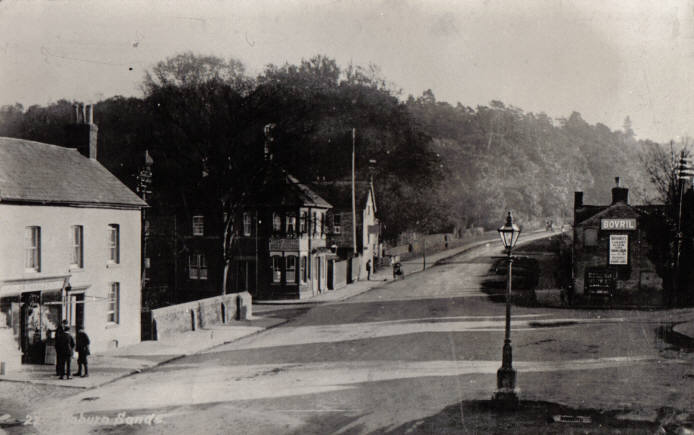
Under a heading of “The Lady and the Whisky“, the Luton Times & Advertiser of 28th May 1915 reported that Miss Ethel Molyneux, who was living in apartments on Aspley Heath, had entered the pub at ten minutes before the legal opening time on a Sunday and asked for a pint of whisky to take away for medicinal purposes. Alexander served here, but she was stopped by a P.c. Genn and P.c. Bunce outside with her brown paper parcel and questioned. At first she refused to disclose what she had bought, but on being taken back into the pub, the story was told. The North Bucks Times also ran the story and outlined how the Petty Sessions heard that Alexander thought he was providing the spirit for a sick friend of Miss Molyneux, whereas actually it was for her There was a long court discussion on how Miss Molyneux was under the care of an attendant who had gone out for a walk and left her alone and why whisky was purchased rather than the more traditional medicine(!) of brandy. The Judge seemed to have some sympathy with them both and did not impose a fine, but shared the prosecution costs between them. Unusually for such an incident at that time, Alexander kept his job, but he was soon involved in another fracas with the police. This from the Luton Times & Advertiser, 21st January, 1916:
“Night Scene at Woburn Sands. Police Charged with Assault. The Woburn Bench on Friday were occupied for a considerable time in the hearing a charge of assault preferred against two constables, William S. Hyde and Arthur R. Genn, in the Bedfordshire Police Force, by John William Foster, machine agent, residing at San Remo, Aspley Heath. The magistrates present were Dr. Waugh (Chairman), Mr. W. F. M. Weston-Webb, Mr. E. Creasy, Dr. Charnock Smith, and Colonel Mercer. Mr. C. C. Bell appeared for the complainant, and Mr. W. W. Marks defended. the police. The affaire occurred on Christmas Eve, when the complainant, it was stated, had occasion to meet a friend off the last train at Woburn Sands and left his motor cycle at the Fir Tree Hotel, Woburn Sands. On coming back from the Station he went into the hotel yard for his cycle and was getting it out of the shed when it was alleged that P.c. Genn came on the scene and roughly laid hold of him, after telling him that he was on licensed premises, and proceeded to him from the yard. P.c. Hyde also came along later and took part in this alleged rough usage. The complainant, it was further stated, was dragged about the yard, and not allowed to have his motor cycle.
The complainant, on oath, giving his version, said that he was told by P.c. Genn that he had no right to be on licensed premises at that hour, and later the constable threatened to “have him on his back in minute,” and took him by the shoulder. The other constable, who was not in uniform, then came and took hold of his other shoulder, but on his appealing to them they allowed him to go back for his bicycle, but again came and “fixed” him the shoulder and pulled him down the yard. Sooner than have any trouble on licensed premises, he asked the landlord to put him for the night. The landlord said he could do so, and P.c. Genn then let go of witness. The other policeman, however, gave him a jerk, throwing him down on the gravel, and then twisting a scarf round his neck, dragged him across the yard and told him to go home to Aspley. That was the last witness saw of his scarf.
The complainant, cross-examined Mr. Marks, said he had lived in Aspley for three mouths, and before then lived in Bedford and Kent. Mr. Marks subjected the witness to a cross-examination. Witness denied that he had shouted or used bad language, but admitted that he had in the Fir Tree for five hours during that day. He alleged that the police did all the shouting, and that they were very excited. George Alexander, landlord the Fir Tree Hotel, said he heard no bad language used by the complainant. The only swear word came from P.c. Genn. The police were terribly excited, and used the complainant roughly. For the defence, Thomas Lawson, road foreman to the Duke of Bedford and a special constable, stated that soon after closing time on Dec. 24th, he saw Foster go to the Fir Tree Inn, and he also heard some shouting in the yard. This was the second time he had seen the complainant enter licensed premises after closing hours, and he informed P.c. Genn. He also sent P.c. Hyde to the house. Foster was shouting and very excited when he was brought out, and there was shouting between the landlord and Foster before the police went near the premises.
Robert Genn, one the defendants, who served 12 years in the 16th and 17th Lancers before joining the Beds. Force, said he had never had a black mark against him since joining. After being told by Special Constable Lawson of what was going on, he found complainant in the Fir Tree yard swearing about the acetylene gas generator. Asked why he was on licensed premises, said, “Go away, I’ll spread you.” The landlord then said, “Shut up, John; keep quiet.” This was repeated several times. Neither witness nor P.c. Hyde were excited, and if complainant had behaved like an ordinary man would have been allowed to go away. The complainant sat down on a drain and said he “would —– well stop there all night.” Then he asked the landlord for a bed. Witness considered it his duty to remove a man in that condition from licensed premises, and with P.c, Hyde lifted him out of the drain and took him outside. The complainant was not in a fit condition to ride a motor cycle. P.c. William Samuel Hyde, the other defendant, said he had been member of the Beds. Police for 13 years, and held both the Boer War Medals with four clasps. Describing the scene in the Fir Tree yard, witness said the landlord asked him to see the complainant off the premises. Supt. Matthews said the defendants had been under him for two years, and he had found them good discreet constables. Counsel having addressed the magistrates, the charges were at once dismissed, the Chairman stating that there was no reflection on the conduct of the constables.”
The Fir Tree appears in only one First World War-connected story that I can find. In November 1917, a Canadian Forestry soldier, Private Albert Parent, (who’s regiment were in the Duke’s woods cutting down trees for the war effort) visited the home of Alice Dora Butcher. She worked as a maid at the Fir Tree and he obviously knew her quite well. She was just going out, so he asked if he could remain in her room until she returned, but when Alice got back, he had gone – along with four £1 notes and two 10s. notes she had been saving for her brother. She had told Albert several days before that she was saving it. It would appear that Albert used to money to get himself and his friends drunk at the Weathercock. Once arrested, he admitted the crime and was fined 15s. along with having to repay the money. Lieutenant Oxley of the Canadian Regt. guaranteed to repay the money by the next day.
After the War, Woburn Sands was very much changed. As well as the loss of so many of the town’s youth, there was never the same ‘tourist’-style appeal. The Depression of the 1920s came and many were out of work.
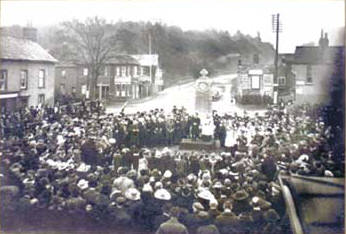
The pub appears in the background of the unveiling of the War Memorial on Saturday, December 20th, 1919, by Herbrand, the 11th Duke of Bedford, with Rev. John Shelton of St. Michael’s and Rev. James Rees of the Wesleyan Church conducting the service. A crowd of about 400 gathered to watch the proceedings. Mr. Ernest Adam Dean conducted a combined choir from the local churches and “The Last Post” was sounded by Bugler Corporal Nobel from Kempston Barracks. The Memorial was officially handed over to John Tarver of Woburn Sands Parish Council.
George Alexander was appointed as a parish Overseer in 1920 for Aspley Heath, administering poor relief such as money, food and clothing as part of the Poor Law system. By this time, he had married again – in the Spring of 1920 – to a Phyllis E. M. Pickin. She was just 20 and he then 50. Her father was a retired soldier working as a Groom on the Duke’s estate, living at Speedwell cottages, Woburn. A son, George Augustus, was born in the first quarter of 1921. The census that year, compiled in June, shows him as the “Hotel Proprietor” of the Fir Tree. The only other residents that night were his new wife and 6-month-old son. A daughter, called Phyllis Margaret, arrived in 1922.
With the assistance of both his new wife and his sister, George stayed running the Fir Tree until 1924. They then moved to Bedford to live at 71 Bower Street, where George died on 12th May 1937, aged 71. Their son, George Augustus, was killed on 21st March 1944. He was a Wireless Operator Sergeant in the Royal Air Force Volunteer Reserve and died when his Handley Page Halifax II (JP137) crashed on Moordown, Bournemouth shortly after take-off. His sister Phyllis Margaret married an American USAAF Lieut. Arthur G. Lynn of Oklahoma in December 1945. Phyllis Alexander was later remarried to a Mr. Taylor.
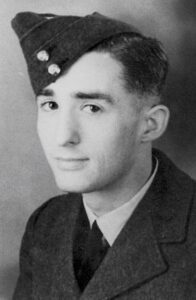
George’s sister, Miss Jessie Emily Alexander, stayed on in Woburn Sands even after George had moved away. She lived to the age of 77 in Russell Street, until her death in 1941.
1924 to 1927 – Francis Robert Beresford
The next landlord was Francis Robert Beresford and his wife, Jane, who took over in June 1924. Finding out about Francis took several decades! He was born 3rd May 1873, near Portsmouth, but he grew up in Battersea. His birth name had been Clements, but when he joined the Army aged just 15, he used the surname Beresford/Berresford. Posted to Ireland with the Royal Field Artillery, he married a local girl there. A daughter was born in Ireland in 1898, before they were moved in India where their next two children were born, during his six-year posting. Another daughter was born in Ireland in 1906, then a last daughter in Hull in 1909. The 1911 census gives him as a Sgt-Major in the Royal Artillery, in Sculcoates, Hull. He left the Army in March 1914 with an “Exemplary” character reference, having completed 23 years and 160 days service, attaining a Long Service and Good Conduct medal and at the rank of Battery Sgt. Major (Acting Sgt. Major).
This was just six months before World War One began. On the outbreak, as a Reserve, he went back to the Royal Field Artillery and reassumed his previous rank, but was commissioned as Temp. 2nd Lieutenant in June 1915. He served in France with the RFA during the war but was gassed in 1916 and returned to Home service. After his recovery, he was posted to Iraq attached to the Royal Artillery Ordnance Corp., where he resigned his Commission in 1922 to join the Royal Air Force, working in the stores on the base as RAF Hinaidi in Basra. His RAF records states he left the army on 27th May 1924 as a Flight Lieutenant and gave “The Fir Tree Hotel, Woburn Sands, Beds.” as his forwarding address, so he must have known he was taking it before even leaving the forces.
There was a Tax Assessment report the year after they started here, which describes the interior in some detail. The bar had three divisions, a skittle room and a smoking room, with four bedrooms and a ‘commercial’ room upstairs. There is also the first mention of a conservatory, which can be seen in later photos of the pub. The large hall was let to the Band twice a week for 1/6 a night. Beresford gave his takings as £624 pa, which the assessors did not believe. They noted in their report that the Swan opposite did 4-5 barrels a week. However, Beresford convinced them that the Swan was in a better position and thus managed to get his rating reduced from £43 to £30!
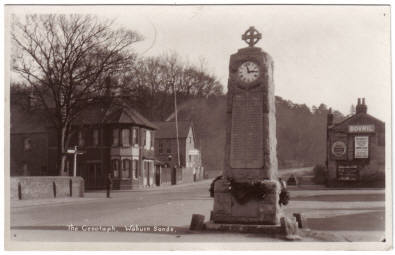
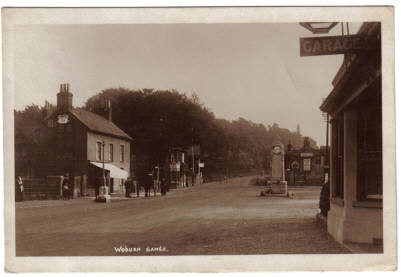
However, Beresford didn’t always get his own way. From the Beds. Times, 5th June 1925:
“LICENSING APPLICATION REFUSED. An application by F. R. Beresford, of the Fir Tree Hotel, Aspley Heath, for four hours’ extension on Bank Holiday, was turned down on the recommendation Supt. James, who said he strongly objected to it. It would not be fair to the other publicans, he said. They could get all they wanted from 10 o’clock 2, and if they should get a drop too much there would time to get straight before the houses opened again.”
The Newport Pagnell Brewery Company, who had been running the Fir Tree since at least 1871 and had owed it since 1876, were taken over by Charles Wells of Bedford. They put the Newport Pagnell premises up for auction in 1920 and later completely absorbed the Newport company. In the schedule of the transfer in 1926, the Fir Tree was listed as:
“No.33: All that messuage or tenement known by the sign of “The Fir Tree” with the yard, stables and outbuildings thereto belonging situate in Woburn Sands in the parish of Wavendon in the County of Bedford and now in the occupation of Francis Robert Beresford.”
About this time, Charles Wells compiled a photographic record of all their estate and a photographer was dispatched to take a photo of every public house they ran. Most of the photos have the licensee standing in the doorway, but sadly the Fir Tree does not.
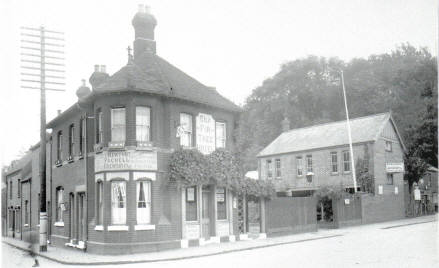
“I am indebted to the late Mr. Charles Howard, one-time Manager of the Woburn Gas Works for the following account of the beginnings of the Catholic Mission at Woburn Sands. It is given exactly as he wrote it, and is of absorbing interest. At the time of writing (October 1975), Tom Casey, one of the few present at the First Mass, is still with us, a very youthful 89, and still singing in the Choir! Please God, he will still be with us to celebrate our Golden Jubilee on 18th July 1976.
An account of the beginnings of the Woburn Sands Mission, written by Mr. Charles Howard, of Gas Works Cottage, Woburn, June 1953.
‘Previous to 18th July 1926, the Catholics of this district went to Mass at Leighton Buzzard or Bletchley. We either walked or cycled. Then, in late June or early July 1926, a priest brought a party of school children from Bedford for a ramble in Aspley Guise Woods.
The day was hot and the children tired and, no doubt, hungry, having eaten their sandwiches. The priest in charge went on a forage for refreshments, and the first likely place he came to was the Fir Tree Hotel at Woburn Sands. Here he enquired of a young lady if they could provide a tea for his party. The lady in question called out: “Daddy, there is a parson here who wants tea for a party of children.”
Was it a coincidence? It was fortunate for our Mission that the proprietor was a Catholic, one Brigadier Beresford, who soon set things in motion. By the way, I should mention here that the priest was Father Dalby, now Dean Dalby at Luton. To him, and the Brigadier, we owe a great debt of gratitude.
The result of this meeting was that on 18th July 1926, the First Mass at Woburn Sands was celebrated in the Club Room of the Fir Tree Hotel. The Brigadier wrote to all the Catholics he had heard of in the neighbourhood, telling us of the great event, enclosing a small handbill. I have one of these by me now. The Mass was at 10.30 a.m. and the Celebrant was the Very Reverend Canon Tonks of Bedford, who preached us a sermon on our good fortune in having the Mass.
The Beresfords had cleaned up the Club Room and had provided the necessary furnishings. Our first altar was a small portable one. Where it came from we did not know. Thereafter the Canon came to say Mass on the first Sundays, hearing Confessions before Mass. He came by taxi and brought a server with him. Father Dalby officiated on the other Sundays. The time of Mass was altered from 10.30 a.m. to 8.30 a.m. Father Dalby used to come to Woburn Sands by motor cycle, a ‘Panther’ (I believe he was a dispatch rider in the 1914 -18 war). He brought along his server on the carrier, and frequently both he and his passenger arrived perished with the cold through travelling at high speed.
After several weeks the portable altar was replaced by one made up by Mr. Beresford, the altar table being a trestle table on which was placed the altar stone taken from the portable altar. This arrangement was all right for the Canon, but was too low for Father Dalby, so we had two higher trestles made to suit; then we had to cut five inches off these to suit the Canon’s stature.
It was surprising how our congregation grew in a few weeks. Worshippers came in from several miles distant, many of them being domestic helps. I must mention here Mr. T. Casey, a resident of Aspley, who played the harmonium for us at Mass and was a great asset to the Mission. In addition to being a great organist, Tom Casey was our Jazz Band Leader, and was indispensable at our Whist Drives and Dances. Our first Whist Drive and Dance was held on 17th November 1926 at the Woburn Sands Institute; so you will see there was no time lost in starting to raise funds for a church. As a result of our first effort we were able to hand Canon Tonks the sum of £12. Our next Whist Drive and Dance was held on St. Patrick’s Day, 1927, at the Aspley Guise Memorial Hall. I would like to mention the help we had from the young folks of Bedford Church. Several times they brought coach-loads of young people to our dances.
In August 1927 the Beresfords left the Fir Tree Hotel to reside near London. We missed their great help very much, but things did not stagnate. The Whist Drives and Dances still carried on. The new proprietors of the Fir Tree Hotel were not of our Faith, but kindly allowed us the continued use of the Club Room; but what a difference there was! We missed the care and preparation which the Beresfords had given to the Club Room. The times of Mass had been altered from 10.30 a.m. to 8.30 a.m., and on some occasions when we got to the Fir Tree Hotel at 8 a.m. we found that the new proprietors were not yet out of bed. Then we had to rouse them, get the key and open up the Club Room which we would find cold, dirty and untidy, and reeking of stale beer and tobacco. We would then hurriedly set to and clean the place up, arrange the altar, wash and fill the cruets, put out the chairs and. kneeling pads, and arrange the vestments over chairs to air. As they were usually cold and damp, we placed them near an oil stove we had bought. I remember one occasion when we arrived the room was in great disorder as the local band had spent a jovial Saturday evening there. Band instruments had been left strewn about the floor and on chairs. We had quite a bit of fun collecting them up and stowing them away before starting to clean up and set the room ready for Mass.
It would not be out of place here to mention the confessional. In the corner of the room was a half-glass bar with shelves and a serving hatch. Here sat the Confessor inside a small clotheshorse, on which was draped a patchwork bedspread. The Penitent knelt on the outside in full view of the congregation. There was thus little privacy and we all had to mind ones step. How we missed the late proprietors in all this discomfort!
There was one occasion when the Canon arrived when we had not had time to get the confessional properly prepared, and so Priest and Penitent alike had to face partly empty glasses, beer bottles and a four-and-a-half-gallon cask under the counter. I apologised to Canon Tonks for the discomfort of his surroundings. He said: “Nevermind, my son, we shall manage”, and calmly carried on as if there was nothing unusual. He was a lovable man and was never flustered. One was always at ease with him.
After carrying on for several weeks in these trying conditions we were able to get the services of a local man (non-Catholic, a part-time postman), to open up the room, clean it, light the stove and air the place. We paid him ninepence per hour. Things were now improving, and we only required to get along early enough to put out the vestments to air. Then there arrived an R.C. man, a wandering tailor, who used the Hotel Saddle Room as a dwelling and workshop. We christened him The Anchorite’. He took over the duties of cleaning out the Club Room and lighting our oil stove. On one occasion, when we arrived we were greeted by a thin curl of smoke from the stove, and an appetising smell of roast cheese and bread. Apparently our stove was being used by him for warmth and culinary purposes.
For several Sundays we had a Father Dunlevy to say Mass. He was an invalid, and was living at Aspley Heath amidst the pine woods for his health.
Soon after this we left the Fir Tree Hotel, and for several Sundays had Mass in the Scouts’ Hut at the back of the council schools. From there we moved to premises at the junction of Sandy Lane and Aspley Heath Road. This was a building which was being altered for use as a tea room. Here we stayed for several weeks, Canon Tonks and Father Dalby continuing to celebrate Mass for us.”
A photo of the Altar at the Fir Tree then existed, as it was used in the production of the above book, but the original has since been lost, as has the handbill mentioned from 1926. What a shame! He was never actually a Brigadier; I think it may have just been a nickname for someone with a military bearing and 33+ years experience in the Army and RAF. No wonder the Club Room was well cleaned-up for Services!
When they left the Fir Tree in August 1927, the Beresford’s did not even wait for the license transfer to be completed, as they had already moved to the “…London area“. His army records were kept up to date with addresses for him for pension matters and show him later living at 159 Stroud Green Road and then 71 Victoria Road, both in Finsbury Park. The family ater lived in Greenwich. Francis died in April 1939 in Guildford Road, Ash, Surrey, with a service at the Catholic Church of Holy Angels. He was described in a small obituary in the local press there as an Army Pensioner.
1927 to 1928 – Tom Saville
The next two landlords managed to run the business for only 14 months between them. From the Beds. Times, 19th August 1927: “Licensing Business. The temporary transfer of the Fir Tree Hotel, Aspley Heath, was granted to Tom Saville from Francis Robert Beresford, who was excused from attendance at the full transfer in September, as he was leaving the district for London.”
According to the licensing records, Saville took over on 23rd September. Nothing at all is known about his time at the Fir Tree; he may just have been a manager put in by the brewery between tenant landlords, but I cannot trace his name in connection to any other Bedfordshire pubs. He officially left again on 20th April 1928.
1928 to 1928 – William Donnelly
Donnelly and his wife Ellen stayed just long enough to arrange some adverts for his combined businesses before they moved on swiftly too. This appeared in the Personal Ads of the Beds. Times, beginning on 30th March 1928:
“W. Donnelly, Fir Tree Hotel, Woburn Sands, specialises in dinners and teas. Parties of every description catered for. – Jockey & Trainer. Hacks and Hunters of every description for hire. Riding taught in three lessons.”
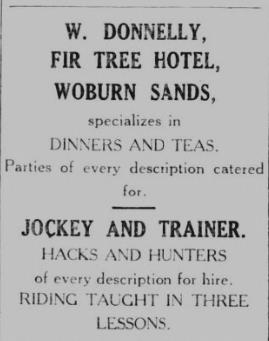
He was obviously making full use of the stable block and harness rooms etc. at the back of the carpark. But perhaps he found it too small, or the riding business wasn’t what he hoped for? There was also a Tom Brierly listed in the Register of Electors as residing at the pub. Donnelly managed the Hotel for just seven months before leaving in November.
1928 to 1929 – John Henry Osborne King
Even less is known about King’s time at the Fir Tree, other than the Beds. Times report of 23rd November, 1928: “LICENSING. A temporary transfer of the Fir Tree Hotel, Aspley Heath, was granted to J. O. King, of Harrow, from William Donnelly, who is leaving the district.”
King has the shortest tenure of all – just six weeks – till he moved on and the revolving door of landlords settled down for a while. A John Henry Osborne King was landlord of the Queens Head on Pinner High Street, very close to Harrow, at the time of the 1939 Register. If it was the same man, he was born in 1889 and died in 1946.
1929 to 1938 – Harold Clements
In January 1929, Harold Clements moved in with his wife, Lavinia Alice, although the license didn’t change until January 1930. We are now at the end of released census data and tracking people is much harder. I don’t know where the Clements had come from. Before the end of the summer, 1929, he had seen a fracas in his pub on the August Bank Holiday, which had made the local press. John Joseph Brown, a miner from Durham, was dragged out of the Fir Tree by Jonathon Butcher, who knocked him down. Brown took refuge in the Swan, but Butcher and George William Cox chased after him, pulled him out again and seriously assaulted him in the road outside. Although both the attackers said the victim had struck the first blow, they were fined £5 with £1 1s. 9d. costs. Mr. Saunders, landlord of the Swan, made sure he had a representative in court to ensure there was no bad reflection on his hotel!
The Bedford Cycle Club came over to the Sands on Sunday, 9th November, using the Fir Tree as the destination. By 1931, there is a Henry Spacey recorded living at the pub in the Register of Electors, along with the Clements. In the Beds. Times of 8th April, 1932, he was looking for more staff: “Girl wanted, good appearance, for house-hold duties and waiting table. Apply personally: Fir Tree Hotel, Woburn Sands.” … maybe to help with the Cardington Sunday School outing who came in August 1932.
A very similar advert also appeared in June 1934:
“Girl wanted, smart appearance, for household duties and waiting at table, wages and tips. – Firtree Hotel, Woburn Sands.”
… and again in May 1935, with the addition of the telephone number:
“Girl wanted, smart appearance, as waitress with household duties: wages and tips; good home. Apply – Firtree Hotel, Woburn Sands. Phone Woburn Sands 127.”
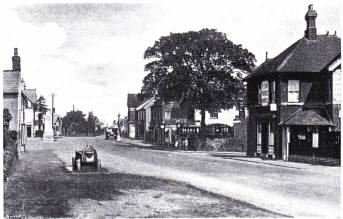
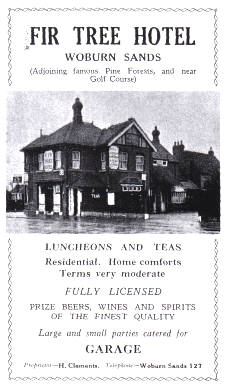
Clements put the advert above in a Woburn Sands Guide Book of the 1930’s and you can just make out there is clearly a new porch and a lean-to conservatory-type building, with a small extension made to the upstairs, to provide a bathroom for the tenants accommodation. I was told by those who could still remember, that the original toilet urinals for the pub used to be in the yard by the side of the little outbuildings, where we stored the bins. (It is shown on plans from 1897 as being underneath where the toilets are now. One had an entrance from the carpark and the other from the back yard.) I can tell you that the little wooden extension building for a toilet and bath for the tenant upstairs was always freezing!
I believe 1934 was the last time that the Fir Tree was used for an sudden death Inquest. William Butcher of Harefield Cottage died in August that year. He had died of a heart attack, aged 59. From 1934, Clements had been involved in running the Woburn Sands Football Club as a Vice President and the pub was used as their base. The Beds. Times reported on 21st June 1935: “CELEBRATION DINNER – WOBURN SANDS FOOTBALL CLUB LEAGUE SUCCESS. By way of celebrating their successful season in the Bedfordshire League (Division IV) they finished second and gained the runners-up medals, the Woburn Sands Football Club held a dinner at the Fir Tree Hotel, Woburn Sands, the Club’s headquarters, on 14th June. Mr. C. Hutton (President) was in the chair, and Mr. Clements, the host, served an excellent dinner. Mr. Hutton presented the medals.”
In the same edition of the paper was an obituary for David Giltrow, who had been landlord of the Fir Tree from 1881 to 1884:
“PERSONALITY By the death of Mr. David Giltrow, which occurred at Woburn on Saturday, the town loses an old and interesting personality. He was eighty-eight years of age, and though he has been in failing health for some time past he was out as recently as a fortnight ago. At a very early age he went to work at straw-plaiting and afterwards engaged in agricultural work. In later years he had gone in for dealing, besides being licensee of public-houses at Woburn, Woburn Sands, Aspley Guise, and Sheep Lane, he was fond of sports of all kinds, had been much in request on the cricket field as umpire: he took an interest in racing, and up to few months ago enjoyed a social evening and a hand at “nap” with old friends and acquaintances. Naturally, Mr. Giltrow could recount interesting experiences of the old coaching days and episodes, in which he took part, concerned the young “bloods” about town. His wife died several years ago, and for the last few years he had resided quietly at the Woburn almshouses, where he had been looked after by a neighbour, Miss Amanda Chisnall. Three sons and two daughters survive him. The funeral took place at Stanbridge Church on Wednesday.”
In 1936, the Woburn Reporter ran a piece on local pub signs. Alas, there is no illustration of what the writer meant! “It is interesting to know that a couple of the signs in the district have been removed from their frames for exhibition at the Building Centre in London. I have often noticed, with some regret, that none of our local houses has been favoured with an example of the craftsmen’s art, though something of that sort hung at the Fir Tree a year or so ago.”
There was a small difference in the times that the pubs on the Square could open until in the evening. Those with licenses issued by the Bletchley bench for Buckinghamshire could stay open until 10.30pm, while those issued by the Woburn bench for Bedfordshire had to close at 10pm. As the county boundary runs through the middle of the Square, this meant the Fir Tree and the Swan had different opening times, with the Swan allowed to open later. In 1936, the local Bedfordshire innkeepers tried to get this changed and Harold Clements took on the job of persuading the Woburn Magistrates Court. From the Beds. Times, Friday 21st February, 1936:
“An application for an extra half hour for the opening of licensed houses throughout the year was granted at the annual licensing meeting for the Woburn Division held at the Town Hall on Friday. The application was made by Mr H. Clements of the Fir Tree Hotel, Aspley Heath, on behalf of the license holders of the Division. The Justices were Col. A. R. Liddell (in the chair), Major C. E. Thornton, Col. E. J. Skinner, Mr C. J. Kilby and Mr J. Charnocke Smith, with the clerk Mr R. Hobourn.
In making the application, Mr Clements said that the licensed victuallers of the Division were unanimous in requesting this extra half hour. There was not a single dissention. They asked for the extra half hour as to bring the Division into uniformity with the neighbouring Division of Bletchley.
A few years ago this application might have been termed “a desirable concession”, but today it was of the greatest importance. The brickworks had been extended and new ones built, and the Government works at Cranfield were in full swing. This meant that the men returned home in the evenings too late to obtain a drink. After their hard manual labour he thought that they were entitled to a little consideration.
Mr Clements said that the competition from the Bletchley Division was so severe that they were feeling it very badly. The main roads through the Division were fairly heavily used, and at some periods of the year it was still daylight at 10pm. It was an astonishing thing that people returning from visits and business upon driving through the Division in daylight should be too late to obtain refreshments.
Since the Buckinghamshire Division had obtained an extra half hour the loss of trade to the Woburn Division licensees had been almost unbelievable. At present moment, many were in bad straits. One could not blame the public for using the houses that had extensions. The licensees asked for equality and an equal chance of earning their living.
In the past they had been commended by the bench on the way they had conducted their houses, and they claimed they should be trusted to have an extra half hour. Though they could not recover the trade they had lost, they could stem the tide of disaster if the application was granted. At Woburn Sands, Mr Clements added, there were two houses within a stone’s throw of each other. One was open and one was shut after ten o’clock in the summer.
The Clerk asked if anyone had any objection to make. There was no response. Supt. Folkes said that the Police had no objection. He would like to see the Division in uniformity with neighbours in regard to licensed hours. The Chairman said the Bench would grant the application, but it did not apply to Clubs.”
At some point, the opening times got out-of-step again. In the 1970-90’s, the Fir Tree could open at 10.30 in the morning while the Swan had to wait until 11am!
I had thought that Clements’ tenure had been fairly uneventful, but then I discovered Herts. Archives had three large bundles of correspondence (D/ELS B254) sent to the pub from the customers of Clements’ other business – dealing in Egyptian, Roman and Greek antiquities. I presume he used the Clubroom for this purpose, as the volume of stock he had on display for selling was quite large. The three bundles cover the entire nine years he was at the Fir Tree, which he always referred to as “The Fir Tree Hotel Museum” in his letters and to himself as “The Curator”.
He advertised in the Exchange & Mart magazine and had customers from all over Britain. After leaving the Fir Tree in 1938, he transferred his collection to Hemel Hempstead and continued dealing there, although not as successfully, as this letter sent in March 1939, shows:
“From the Crest Private Museum, 57 Hill Field Road, Hemel Hempstead, Herts. To Thomas Clegg Esq.
Dear Sir, I thank you for your letter to hand, and as requested I have pleasure in sending herewith the small Egyptian specimens I advertised in the Exchange & Mart, You will find them in fine preservation, and each is guaranteed to be perfectly genuine, so that I feel sure that you will be pleased with them. This Museum of Egyptian, Greek and Roman Antiquities has been on exhibition in Bucks for the past ten years and was removed to above address in August last. But this proved to be a mistake, as we find that not only are we too isolated here to attract visitors but the accommodation to display the collections is quite unsuitable. So all concerned have come to a reluctant decision to disperse the Museum and sell off the specimens to collectors – a very great pity, but it cannot be helped. The Antiquities were originally obtained from the famous collections which were dispersed, and all have since been examined and verified by the British Museum experts, so their authenticity is thus doubly guaranteed. And as low prices have been placed on them to ensure a quick dispersal (regardless of their original cost) I think you will agree that it is really quite a unique opportunity. I have no list or catalogue, and you will appreciate that it would hardly be worth while compiling one because it would at once become out-of-date when a few specimens were sold. Besides which, I do feel that a collector should have the chance of examining such things before deciding to purchase. But I should be most happy to send you a nice selection, on approval for your pick, if you will permit me to do so. So in your reply will you kindly say if you agree to my suggestion? I can promise you a very interesting choice. Perhaps you will mention if you have a special interest in any particular types, or would you prefer to leave selection to me? Besides Bronzes, Amulets, Vases, Statuettes, Necklaces of several types, etc., the Museum is particularly rich in Scarabs, as there are over 200 selected ones in our cases – Royal and otherwise.”
I later bought some envelopes from an internet auction, all sent to Clements at the Fir Tree in the 1930’s. Whilst the first is addressed just to “H. Clements, Fir Tree Hotel” in 1931, the rest have variations of “The Curator, Museum Dept., Fir Tree Hotel” used up to 1938. Sadly, none still had the contents in, to see what people were buying from him. The collection at Herts. Archives is so unique it was used as the source material for an 11-page coda to someone’s dissertation on “Popular Antique Collecting and the Second-Hand Trade in Britain, c. 1868-1939” for their Doctorate of Philosophy degree!
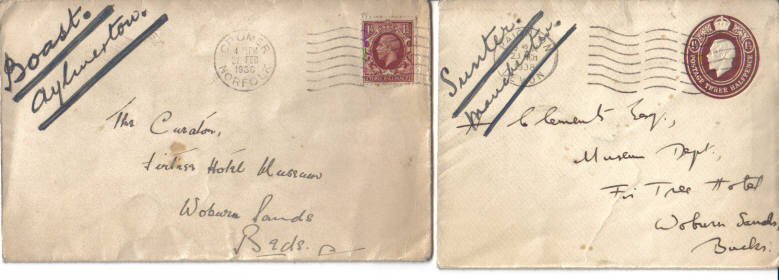
1938 to 1951 – Sidney Hughes
Clements left for Hemel Hempstead, along with his artefacts, in 1938 to be replaced by Sidney and Ivy Alice Hughes. The Hughes’ ran an advert in The Times newspaper in May 1939, under “Hotel Assistants”, saying they required a General Maid and occasional help in lounge during weekends. The hotel telephone number was gradually increasing; having been just ‘Woburn Sands 127’ in 1935, by 1939 it was ‘Woburn Sands 2127’.
At the end of September 1939, an extra census-type Register was created, in order to issue all British citizens with a wartime ID card. This shows both Sid and Ivy had been born on the same day, 14th December, in 1897. Sid was described as a “Licensed Victualler” and Ivy as “Unpaid Domestic Duties”. Also living at The Fir Tree were John G. Hutton, 31, a brickworks lorry driver; Matthew H. Allen, 45, civil engineer and clerk of works; and John (56), and Jeannie (54) Naish. While Mrs Naish was also engaged in Unpaid Domestic Duties, John was a “Printers Proof Reader and Oriental Languages Expert”. I thought there may be some connection to Bletchley Park, but I have not been able to prove this and the date would be a but early.
Having their birth dates enabled fining them through online genealogy sites. Sidney was born in Wellesdon Green and Ivy at Hendon, indeed on the same day. Sidney spent some of his youth in Upperthong, Yorkshire, with his grandmother. In the First World War he had served overseas with the London Regt. He and Ivy Alice Young were married in 1922.
There is a large gap in the knowledge about the pub here; apart from an advert: “TWO DALMATIAN bitches for sale, aged 7 weeks.— The Fir Tree Hotel. Woburn Sands (Tel. 2127)” in the Beds. Times of 27th August 1943, the next item after 1939 is an advert in a local bus and train timetable of 1951 and a few reports of the Darts team. What happened in the war years? The local papers were restricted in what they could print, due to regulations and the scarcity of paper to print on. Many of the staff from Bletchley Park were billeted in the surrounding area, so possibly there were code-breakers staying in the rooms of the Hotel. We know that several of the local houses were used in connection with Bletchley Park, for billeting etc. and that London evacuees were sent here in the early days of the Second World War.
After the war, the local papers changed their emphasis on reporting and the columns of town life became focussed on flower shows, school awards and the Women’s Institute. The kind of scandalous details about arguments and fights had been painted out of the picture. As well as local papers concentrating on bigger issues than village gossip, the golden years of picture postcards was now over and not much seemed to be happening in Woburn Sands – not that got recorded anyway!
Page last updated Mar. 2023.
